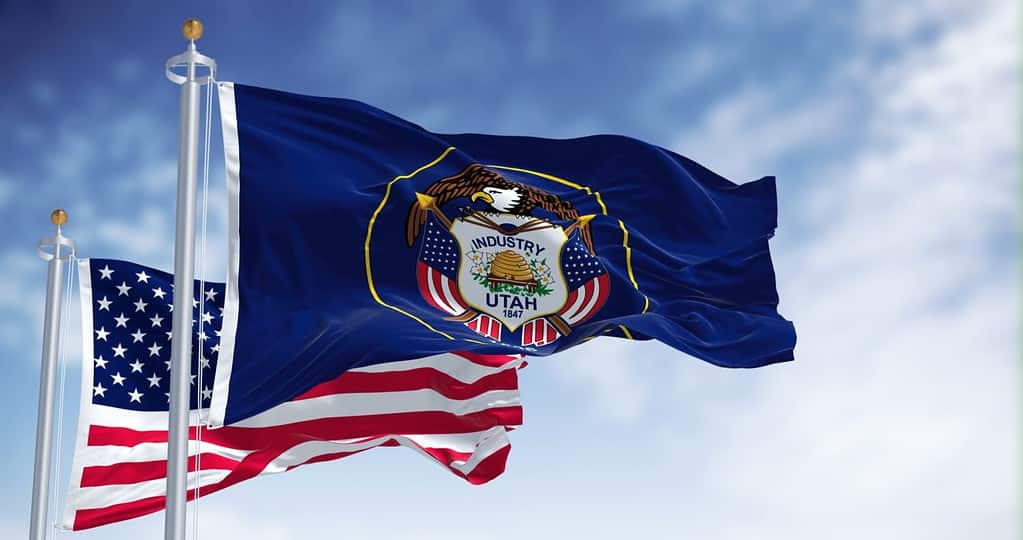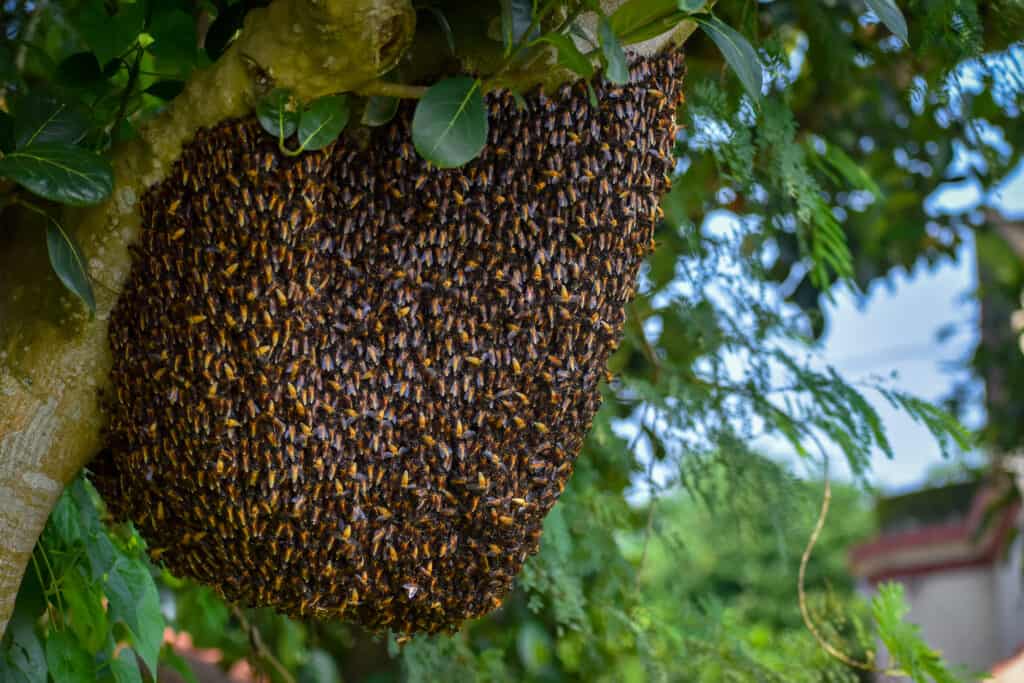Symbolism has always been an important part of human history and language. We use symbolism to express ourselves, convey ideas, share faith or commonality, or reflect the qualities of something. Every state in the United States is imbued by humans with a variety of symbols. This symbolism is meant to represent the shared values, ideals, and aspirations of the state. It can share cultural heritage and it can also highlight unique aspects of each state. The western state of Utah has plenty of its own symbolism, including its state emblem – the beehive. Why did Utah choose a beehive as its state emblem? We’re going to check out the meaning of this state emblem – and touch on other state symbolism – in the following sections.
Why is Utah Called “The Beehive State”?

In this photo of
Utah’s state flag
, you can clearly see that a beehive is the central focus of the flag.
©rarrarorro/Shutterstock.com
There are a couple of reasons for Utah’s state emblem. The first is, perhaps, the most significant. When early European settlers of the state arrived, they saw the vast beauty of the land but realized that it lacked significant resources. Without these integral resources, it was a struggle to settle and survive the area. However, many people still chose to adopt the lands as their own in spite of the challenges they faced. They realized they would have to rely on their own wits and sense of industry to weather the terrain.
Bees are famously industrious. Most bee species work together in a hive to create an environment that keeps the entire colony safe, productive, and communal. This powerful teamwork benefits every member of the colony and serves to create an environment that is suitable for a thriving life. Early pioneers and their descendants felt that this was exactly what they were doing, as well. The state motto of Utah, “Industry”, is reflective of these experiences and values.
Further, Utah is a state with a Mormon majority. Mormons are members of a religious group called “Mormonism”. Mormonism is the principal branch of the Latter Day Saint movement of the 1820s. Around 66 percent of Utah is Mormon. They also share a common symbol – the beehive. Mormon presence in Utah is a great contributor to the reason the beehive was chosen as the state emblem.
What is the Meaning of the Beehive?

Bees play a very important role in Utah’s tradition of symbolism.
©Nandalal Sarkar/Shutterstock.com
Mormon leaders in the 1840s felt the beehive was representative of the kingdom of God. Ancient civilizations, such as the Ancient Egyptians, also saw the beehive as a divine symbol. The symbolism of the beehive has varied through history and religion. Sometimes, it is seen as a symbol of power, while others it is considered a symbol of productivity, cooperation, and royalty.
It is little wonder that the Mormons adopted such powerful symbolism to represent their faith. The focus on royalty originally stemmed from the belief that beehives were run by a “king bee” rather than a queen bee. Mormons compared this to their king – God. They saw the king bee as a representation of the God they served. Brigham Young, the leader of one Mormonism movement, believed the state should be named “Deseret”, which means “honeybee” in the ancient language of the Jaredites.
Progress often changes perception, and the meaning of the beehive changed as the United States developed democratic ideals. Modern interpretations of beehive symbolism lean heavily on a sense of democracy, industriousness, and economic well-being. Each worker bee’s contribution to the hive was highlighted, which shifted focus from the concept of a “king bee” toward the idea that each person in a community has an important role to play. This idea of hard work and cooperation stands strong today and is representative of Utah’s values.
In fact, the Utah State Capitol website states, “Bees symbolize a community that works for the good of the whole. Each bee does its part in providing for the entire swarm. For the people of Utah, the beehive symbolizes the Utah community as each person in Utah works together to support and help one another and to create a successful industry.”
When was the State Emblem Adopted?
Utah adopted the beehive as its state emblem in 1959. This same year, they adopted “Industry” as their state motto. This choice served to highlight the hard work of the past while establishing a sense of togetherness in the present. The decision to adopt the beehive as an emblem was widely approved. Mormons in the state felt represented in their faith while other residents felt their values of community and history. The emblem is not the first adoption of the beehive in Utah. In fact, the beehive has been an integral symbol in the state’s development since its founding in 1896. The state seal and the state flag were both embellished with a beehive when Utah achieved statehood. The very first adoption of the beehive as a symbol for Utah dates back to 1848.
As you can see, the answer to this question is a little convoluted and may depend on who you ask. In this case, all three answers are correct, but we will rely on only one to check all of our boxes. 1959 is the year that the state officially adopted the beehive as a symbol and wrote it into the legislature.
Other Bee Symbolism in Utah
The state emblem is not the only official bee symbol in Utah. In fact, Utah’s state insect is the honeybee. The state has also adopted the “beehive cluster” as its official astronomical symbol. This cluster of stars is one of the largest and closest open star clusters to Earth and contains over 1,000 stars. You can see how deeply the people of Utah feel connected to bees and beehives as a part of their symbolism and way of life. But what about actual bees?
Bees in Utah

Many bee species are solitary. Golden honeybees, like the one pictured above, are colonizing. This means they spend their lives in a large hive instead of in a lone nest.
©yod 67/Shutterstock.com
Over 1,100 species of native bees inhabit the state of Utah. Interestingly, many of these bee species are solitary. What does that mean? Well, a solitary bee species does not rely on a colony as honeybees and bumble bees do. Instead, a lone queen female bee creates her own small nest. Many solitary bees nest near to each other, but they do not share a hive or colony and there is no queen bee. Consequently, these bees do not produce honey. One advantage of solitary bees for humans is that these bees are often more docile. Male solitary bees have no stingers and female solitary bees are non-aggressive to the point of being generally safe around pets and children. Female solitary bees only sting when roughly handled.
There are a number of reasons this is so, but the main one is a lack of resource guarding. Since these bees have no hive or honey to protect, they do not feel the need to be aggressive or defensive. These bees are still excellent pollinators and their gentle manner encourages humans to leave them alone to do their important environmental work.
Native bees are much more effective pollinators than non-native bees. A few species of solitary bees, such as alkali bees and blue-orchard bees, are used in commercial pollination efforts. Utah State University has some excellent information on the benefits and efficacy of these bees in maintaining a healthy and productive environment.
Other State Symbols

Copper is the state mineral of Utah. Here it is in its ore state.
©iStock.com/RHJ
Now that we’ve explored the hive, let’s branch out into other state symbolism for Utah. You can check out this handy guide written by our very own Kirsten Harrington about all of the official state animals of Utah – including the honey bee. Instead of talking about animals, we’ll look at a few other state symbols. After all, Utah carries a lot of state symbolism! An interesting note: some states adopt symbolism distinct from other states. Tradition often dictates these choices and not all states share the same traditions. For example, not every state has adopted an official state firearm, cooking pot, or railroad museum. Utah has adopted all three.
The state firearm of Utah is a Browning M1911 automatic pistol. The Dutch oven represents the state cooking pot, calling back to a long line of pioneer and Mormon traditions. Texas and Arkansas have also adopted the Dutch oven as their state cooking pot. The Ogden Railroad Museum – Union Station – stands as Utah’s official state railroad museum.
Further, skiing and snowboarding are the official winter sports of Utah, while the Spanish sweet onion is the official state vegetable – not to be confused with the state’s official historic vegetable (the sugar beet). The state rock is coal, the state mineral is copper, and the state mushroom is the porcini mushroom. Utah even has a state fossil and a state folk dance – the Allosaurus and the square dance, respectively.
Summary
Symbolism is an important part of the human experience and often goes deeper than we think. We use it to share ourselves, our lives, our cultures, and our histories with the world. It is a beautiful thing that we have learned so many different ways to express ourselves. However, we cannot rely on this symbolism to guide us. It serves to remind us of our roots and ideals, but it is not the true compass for our lives. It is very easy to fall into seeking symbolism in all we see and do, which prevents us from leading fulfilling lives. Symbolism should only be used to enhance our experience, share our story, and relate to others. It is incredibly important – and very interesting.
Did you know states had so many official symbols? Do you know the official state symbols for your state and are you aware of what they mean? Do any of the official symbols of where you live bear personal meaning to you? All of these questions and answers help to lead us to a sense of tradition, culture, community, and togetherness. We have so many ways, as humans, of sharing our beliefs, ideals, and interests. State symbolism is only one example of the ways we are always looking to unite with our fellow man and celebrate our lives on Earth. Can you think of other ways we like to share?
Think about your life. What symbolism would you use to represent your individual experience? Do you think other people would choose the same – or similar – symbolism? The beehive as Utah’s state symbol is only one example of our ability to share a common ideal and represent it proudly. Surely, you can think of hundreds more examples of this same sense of sharing and community values.
Thank you for reading! Have some feedback for us? Contact the AZ Animals editorial team.








